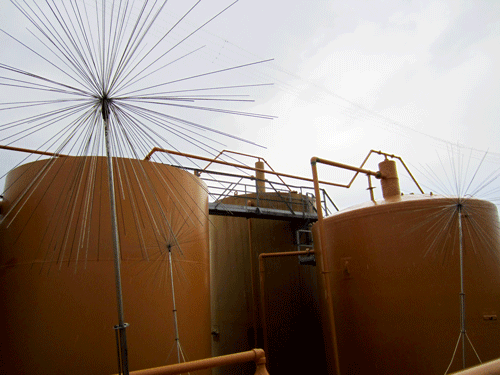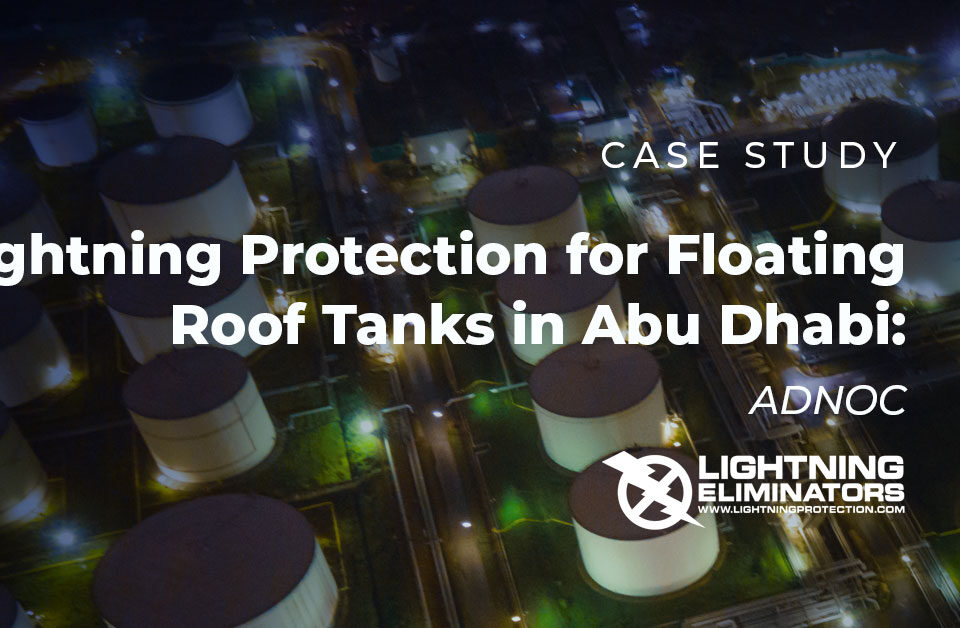
Lightning Protection: Exporting is as Risky as a Lightning Strike
February 21, 2014
Lightning Protection Standards: Part I – “You have Choices!” | Part Three Misspelled, Misunderstood and Manhandled Series
March 14, 2014Lightning Strikes and Tank Batteries go Up in Smoke: Tank Battery Protection against Arc Discharge Events

Lightning Protection
Lightning Protection Blog
Week 77
February 27, 2014
by Sean Carpenter, Solutions Analyst, Lightning Eliminators
Electrical discharge & subsequent explosive detonation of the ullage inside chemical storage tanks:
In recent years there has been a growing trend in the use of fiberglass storage tanks in the oil and gas industry. The majority of these tanks are used at remote well sites and salt water disposal sites located throughout the United States. According to the American Petroleum Institute (API), fiberglass tanks should not be used for oil production but, because of the corrosive nature of this production process, fiberglass tanks are typically the preferred storage method at these locations. Fiberglass tanks, due to their non-conductive construction, create a number of challenges that directly relate to the effects of a lightning discharge. If a fiberglass tank is adversely affected by a lightning-related event, the results can be monumental with some of these lightning-triggered events costing millions of dollars for product loss, cleanup, capital loss and litigation. Even if the tanks are not struck directly by a lightning termination, a nearby lightning strike can still create an internal spark that can and, in some cases, will lead to an explosive event and a catastrophic failure.
High electrostatic fields produced during thunder and lightning storms create vulnerability through both primary and secondary sources causing arcing both internally and externally which can lead to:
- Explosive detonation
- Electronic and electrical degradation of I&C systems
- Complete shutdown or failure of operational systems
- Dangerous step and touch potentials
Lightning Eliminators and Consultants Inc. (LEC) has developed a number of products to address the primary and secondary effects related to the lightning phenomenon to ensure maximum site and tank integrity. In addition to the protection from direct lightning strikes, LEC manufactures a complete line of AC power low and medium-voltage surge protection devices as well as low-voltage surge protection.
The cost to design a solution for as low as $1000 per tank
LEC’s patented lightning-strike prevention system bleeds off the induced potential on the protected area and tanks during the course of the thunderstorm thereby reducing it to a much lower level in relationship to the surrounding environment. The thunder cell above the tanks and area of concern creates the induced charge. With this technology, the lightning impulse is not encouraged, but discouraged.
Arc Mitigation Solution Components
Each facility has different needs and concerns. Different products are used in order to design the proper solution for your facility. Below are just a few of the products that LEC uses when creating the best custom solution that meets your company’s needs.
Lightning Protection
Dissipation Array® System (DAS®)
The patented Dissipation Array System has over 99% effectiveness and eliminates the threat of lightning-strike formation within a protected area by using charge transfer technology to keep the electrical field below lightning potential. The DAS is a custom-engineered system protecting over 3000 installations worldwide and covered by LEC’s “No-Strike” warranty providing terms and conditions are met. For additional information visit www.lightningprotection.com/das/.
Spline Ball Ionizer® (SBI®)
The Spline Ball Ionizer is UL listed and used to supplement DAS and/or for structures that require lightweight protection with a low-wind profile. When used as primary protection, the SBI acts as a hybrid ionizer/air terminal, preventing most strikes and collecting any it cannot prevent.
Streamer Delay Air Terminal (SDAT)
The SDAT is the least expensive of LEC’s lightning protection products unlike traditional lightning rods which are designed only to collect strikes. The SDAT is also UL listed and designed to delay upward streamer generation and reduce the risk of direct strikes.
Grounding Protection
In-Tank Potential Equalizer™ (IPE™)
The IPE is made specifically for non-metal and lined tanks. When the IPE is inserted into a tank and externally grounded, it will discharge any static electricity within the tank’s contents and also keep the potential of the tank’s contents equal to ground potential. In addition, connecting the IPE to an external ground will create a partial Faraday cage, thus further limiting the electric field strength within the tank. The effects of the IPE will minimize the possibility of electrical discharge and vapor ignition within the tank. For more information visit www.lightningprotection.com/ipe/
Surge Protection
Surge Products
Lightning and other transients can easily damage or destroy sensitive electronics, causing expensive downtime and repairs. Lightning Eliminators offers a full line of surge protection devices for all of your critical applications, backed with expert consulting and support.
Should you require additional information on this subject feel free to contact Mr. Carpenter at SeanC@lecglobal.com.
Additional information can be found in our white paper on the subject “Chemical Storage Tank Arc Discharge Mitigation” written by Albin J. Gasiewski Ph.D., CTO, Enventa, LLC and Lee B. Howard, Electrical Engineering Manager, Lightning Eliminators & Consultants, Inc. November 2, 2013 visit https://www.lightningprotection.com/chemical-storage-tank-arc-discharge-mitigation/ to access.
As always if you have any question about this blog, lightning and/or lightning protection feel free to contact me at LightningDiva@lecglobal.com
Additional Reading:
In-Tank Potential Equalizer (IPE)
White Paper: Chemical Storage Tank Arc Discharge Mitigation
Salt Water Disposal Tank Bonding Guide



